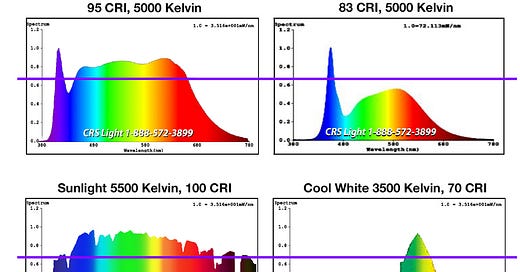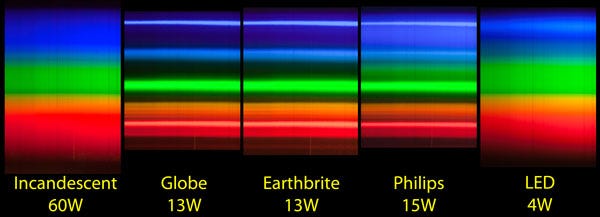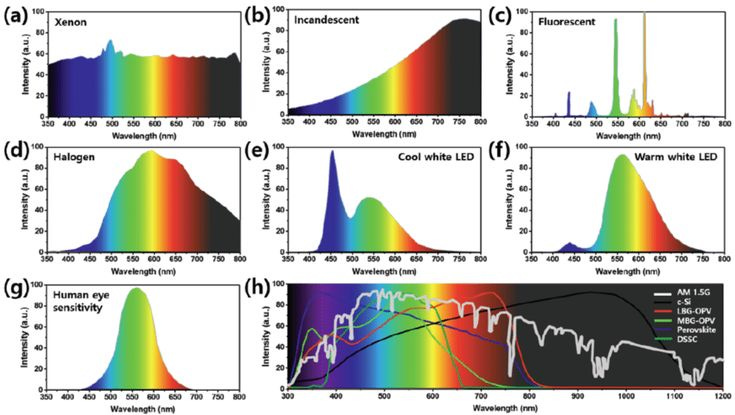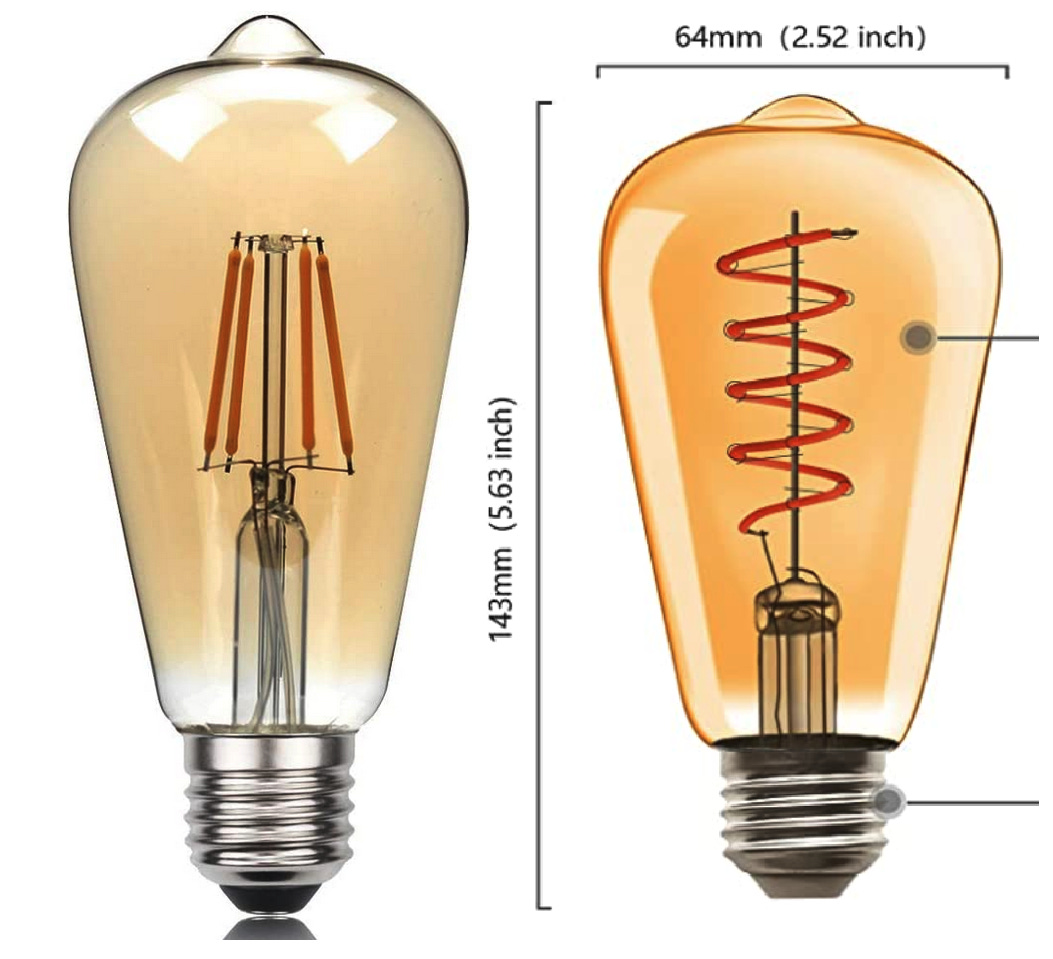Advice on LED light bulbs, and the spectral outputs of many others
Another example of how things are not all politics here.
At this point I’ve tried at least 60 different variations of LED light bulbs. There are plans to ban even more types of incandescent and halogen bulbs in the future, in the name of preventing man made global warming, and this time the ban will also include the hideous garish compact fluorescent bulbs. So it’s possible that LED bulbs may be your only choice for many light bulb types in the future.
Fluorescent bulbs have always been fairly terrible in terms of light quality. They also contain toxic mercury, so when you break one inside your house it’s really a type of hazmat issue. Years ago when Glenn Beck was still on Fox News he had a fairly amusing Earth Day segment on what to do if you break a CFL bulb. (Do not be complaining to yourself how there are political aspects here in what was supposed to a non political piece. At least I didn’t tell you that of course it’s democrats who want to ban more types of bulbs.)
Other than the toxic mercury, the reason CFL bulbs are terrible can be seen in the spectrum of their light output. The older fluorescent bulbs found in offices decades ago were much worse, but you can get an idea by looking at the graph in the upper right of the photo below, and imagining that blue peak is even stronger and everything else from greens to reds is nearly flat at the bottom. Take a look at sunlight on the lower left and you see the huge difference, especially in the red output.
The “CRI” shown refers to ‘Color Rendering Index’, and a value of 100 means perfect color rendering. Anything less than 100 and colors start to look different. You should doubt that claimed 83 CRI on the 5000K bulb. You can find CRI values listed for many bulbs when shopping online, but there is a caveat. The values will be an average for all colors, so the true CRI for red will always be lower than that shown. Ditto for orange and probably yellow too. And that end of the spectrum is crucial for skin tones. (If you’re not from Mars with green skin.) CRI is not the same as “color temperature”, and I’ll also get to that later.
Fluorescent bulbs were improved over the years, and back in 2010 a guy in Canada did some testing of CFL bulbs against an incandescent and an LED using a diffraction grating. A diffraction grating doesn’t quantify the output as well, but you still get a pretty good idea. The CFL are the ones in the middle with the distinct output lines.
I’m old enough to remember using a diffraction grating in school, and with the old style office fluorescent tubes the green and red output lines were not there at all. It was one strong thin line in the blue and then a fainter line in the violet if I remember right. I’m sure about the strong blue line. As you can see, even with decades of improvements the fluorescent bulbs still feature distinct narrow bands of output, while the incandescent has a full spectrum.
To get a better idea of light output differences, check out the graphs below. Sunlight has a perfect 100 CRI, and so do incandescent bulbs and halogen bulbs. There will be some exceptions with coated incandescent bulbs like bug lights and other color coated bulbs, but a glowing tungsten filament alone produces a full spectrum and offers perfect CRI as long as it is bright enough for your eye sensitivity. In graph c you can really see just how pathetic fluorescent bulbs are, in spite of the fact they started mass production in the 1940s. Just a few narrow peaks of output. If it were up to me and I had to ban any light bulbs, it would be fluorescent bulbs and I would have done it long ago.
In the graphs for incandescent and halogen (b and d), you see the key feature that nearly all other bulbs lack, and that is substantial output in the reds. The shape of that output graph will vary from bulb to bulb, but with all incandescents and halogens that do not use colored coatings on the exterior glass you’re getting a full spectrum with no peaks in it. That’s what you want.
As you look at the right side of each graph, you see that they stop at 800 nm (nanometers) wavelength. Human vision runs from about 380 nm on the violet side to about 750 nm (depending on who you ask) on the red side, and as you get beyond that you’re getting into infra-red, which is also known as heat. So you can see visually why incandescents and halogens get so hot.
If you’re running the air conditioner in your house this heat from your light bulbs works against you and just costs you more on your electric bill. In cold weather where you need heat sources to keep your house warm, this extra heat is not wasted at all since it helps to heat your house, so any energy savings for switching to LED bulbs is negligible. This is especially true if your home has electric heat which almost always costs more than heating with natural gas.
If you live in Southern states, year round LED bulb use will save you a good bit on lighting costs, but lighting costs pale in comparison to your AC costs and other electrical usage. So unless you’ve got a huge house like Al Gore and hold various events frequently where you need the place lit up like Westinghouse for several hours per day, after you get off of your private jet, while you’re claiming to save the planet, don’t expect LED bulbs to make that much of a change in your electric bill.
Taking a look at graphs (e) and (f) above you get to my main advice on LED bulbs. What you find the most of are so called “daylight” bulbs listed at a color temperature of 4000K (Kelvin) or 5000K. If you have decent color perception, the output of these “daylight” bulbs does not remotely resemble sunlight, which is what I consider “daylight”. The so called “cool white” bulbs generally have a color temperature listing of 6000K or more. You do NOT want any of these higher K rated bulbs if your goal is the most natural light that is the easiest on your eyes.
The bulbs listed as “warm white” will have a color temperature of 2700K or 3000K. These are the bulbs you want, and opt for the 2700K over the 3000K if all else is equal. Compare graph (e) with its big blue peak to graph (f) with its vastly reduced blue output as well as much more output from green into red. While it’s not equal to halogen bulbs the overall shape is much more similar, and that horrid blue peak is gone.
The most glaring example I ever saw in the visibility difference between bluish light and yellowish light was about 30 years ago. I was outside at night in a parking lot, and there was one of the old style mercury vapor street lights (That used to be everywhere decades ago.), and then a short ways away there was one of the newer high pressure sodium vapor lights that are pinkish yellow to yellowish orange, depending on the model and on how you want to describe them. I noticed a general color difference first as I was trying to figure out what color a certain car was under the mercury vapor light, and then I noticed the difference in details as well. Not only did the bluish light distort the colors such that you couldn’t tell for sure, but it also obscured details in a major way. I still remember it all this time later because the difference was so extreme.
On a related note, there is a reason that some cell phones have an option to reduce blue output, as do some TVs and some computer monitors, and that they make special glasses to block blue light too. And you probably noticed that certain vehicles have horribly bluish headlights which are far worse than just bright headlights when they are coming at you. Even though the human eye is less sensitive to the blues, excessive blue is detrimental to human vision and per some experts detrimental to your health. From the linked article:
The high color (colder/bluer) temperature of fluorescent light stimulates the non-visual pathways from the eye to various parts of the brain that involve biorhythms (e.g. “the body clock”), stress hormones, emotions, arousal levels, and muscle tension.
According to a research summary of CFLs’ effect on stress reactions, the spectral composition from CFL bulbs does not just suppress melatonin, but directly triggers a fight or flight response via hormones, biorhythm disruption, and stimulation of the brain’s arousal center.**2 Research consistently demonstrates fluorescent lights raise stress markers, such as reduced heart rate variability, raised blood pressure, increased skin conductance, stronger startle response, reduced drop in body temperature during sleep, increased cortisol, and reduced slow wave (stage 4, the deepest stage) compared to full spectrum incandescent lighting.3 4 5 Since there is evidence that radiation and dirty electricity also induce stress reactions, the stress effect of CFLs is troublesome.
There are numerous sources listed at the bottom of that linked page. While the focus is on CFL bulbs the same concepts apply to garish bluish LED bulbs. The article is from 2014 and there were far fewer LED bulbs available back then, and the earlier LED bulbs were also even more like fluorescent bulbs in their bluish light output. The blue spikes were larger than that shown in graph (e) above. In the past 5 years at least, there are far more “warm” bulbs that have reduced blue output and also have higher CRI ratings.
While there tends to be some relation between color temperature and CRI, there is certainly no guarantee of a correlation. I have serious doubts about any bulb that is 4000K or higher in temperature claiming even an 85 CRI. Maybe even 80 CRI is questionable for any these bulbs. I would guess that many of them have no more than a 60 CRI for red only, and they only do well with blue and violet colors such that the overall average ends up at 80 CRI. Maybe one day there will be a useful regulation that forces a standardized measurement with a CRI number for each color in ROYGBIV.
As I mentioned earlier a 100 CRI means perfect color rendering, and you get this with sunlight and pretty much all uncoated incandescents and halogens. Among even the best common LED bulbs, you will be hard pressed to find a 95 CRI, and if you do find that claim be skeptical. I do have multiple different bulbs of 2700K and 3000K that claim 90 CRI, and they are pretty good. For most uses at full brightness you will not notice a difference from your incandescents and halogens with those good LEDs. When dimming LED bulbs, you will not get the nicer warm glow at low light that’s closer to sunset, or to candlelight or a fire like you get from incandescents and halogens, nor will you get as full a range of dimming. In general though the dimming capability is still usable and is probably better than CFL bulbs that claim dimmability.
If you want even better mood lighting, especially in low light situations like private dinners, dates, etc., look for LED bulbs with an amber coating that are rated at 2500K, 2200K, or even 2000K. These are even “warmer” and more yellowish in appearance, and as long as you don’t need bright light they are very pleasant. If you do need somewhat bright light you can still get it using these very warm bulbs in a multi light ceiling fan kit or a chandelier. Here are two different coated LED bulbs I have, and the one on the right is rated at 2000K and a CRI of 90:
Another caveat for LED bulbs is that their equivalent wattage ratings are often exaggerated. The one on the right for example is rated as equivalent to a 40 watt incandescent, but I estimated it to be closer to a 20 watt equivalent. This 50% is worse than most discrepancies to be sure, but expect a 60 watt LED might be more like a 50 watt or even 40 watt incandescent, and 75 watt rated LED might be close to a 60 watt in incandescent. Compare the lumen ratings if they are available to get a better idea. LED bulbs usually have a lower lumen rating than the incandescent that they claim they are equivalent to.
The final caution I have on LED bulbs is the listed super long life. They are very likely to last a good bit longer than incandescents (FYI, dim your incandescents or halogens just slightly and don’t use them at full brightness much at all, and their life gets MUCH longer.), but the 20,000 hour and longer claims are suspect at best. With the Chinese made LED bulbs (and this will be the majority of all LED bulbs) you may have such poor quality that they are broken in the box, or fail in less than one year. One of my first LED bulbs was actually one of the supposedly very good Cree models, and it failed way before it’s claimed life.
So overall don’t expect miracles from LED bulbs. They’ll save on electricity for most people in the U.S. and they’ll probably last longer, but their light output can still not match incandescents and halogens. Only buy 3000K or lower, and try to get a 90 CRI or higher if possible. Don’t settle for less than 85 CRI at all, and compare what you get side by side to an incandescent or halogen, and return the bulb(s) if they don’t at least come close. You may have to shop online to get a good selection to choose from.
If you’ve been using CFL bulbs for years and thought their light output was just fine, you may have color perception issues. That still doesn’t mean that you won’t get any benefit from choosing bulbs with way less blue output and a wide spectrum. Toss those horrible things in the hazardous waste and get warm LED bulbs.







Just leave my incandescent light bulbs alone. The federal government needs to back off.
Thanks for shedding light on the mysteries of the light bulb aisle at Home Depot! And special thanks for pointing out what should be obvious to everyone: that incandescent bulbs provide useful heat, so they don't "waste energy" as much as the gov't would have us believe.